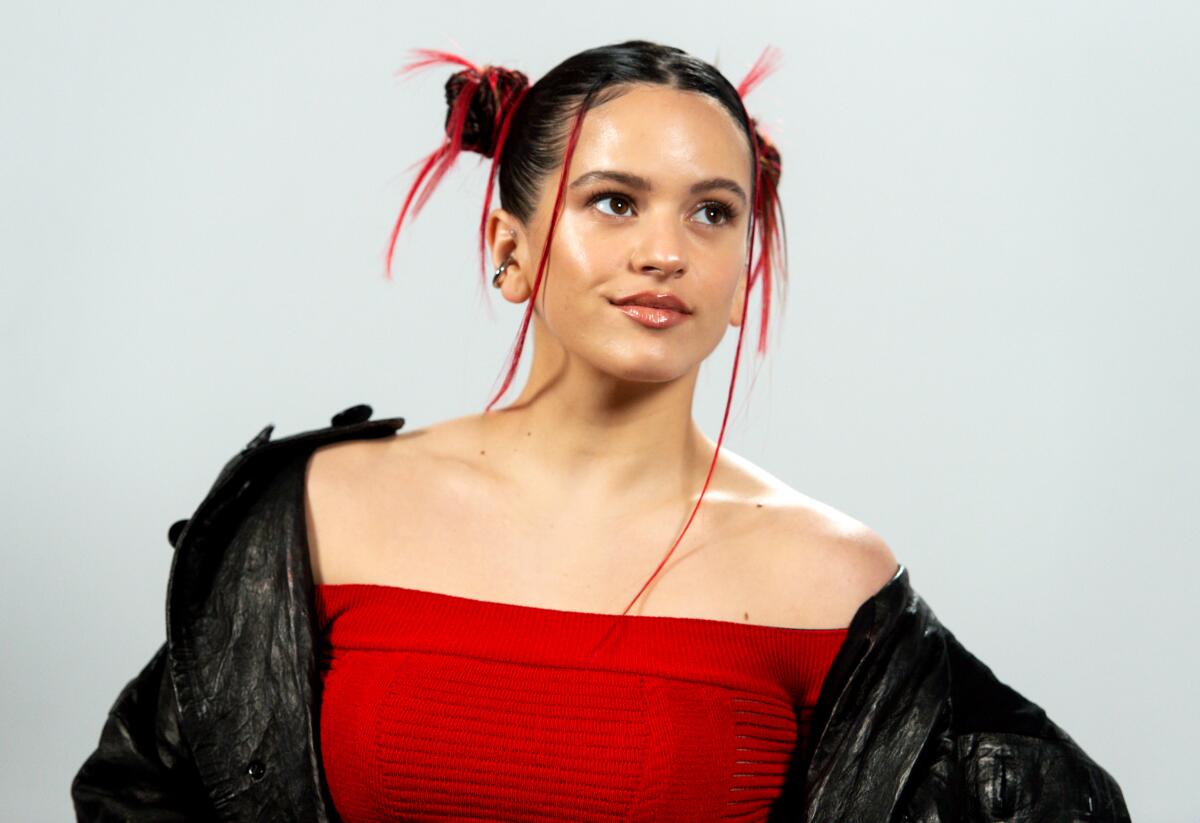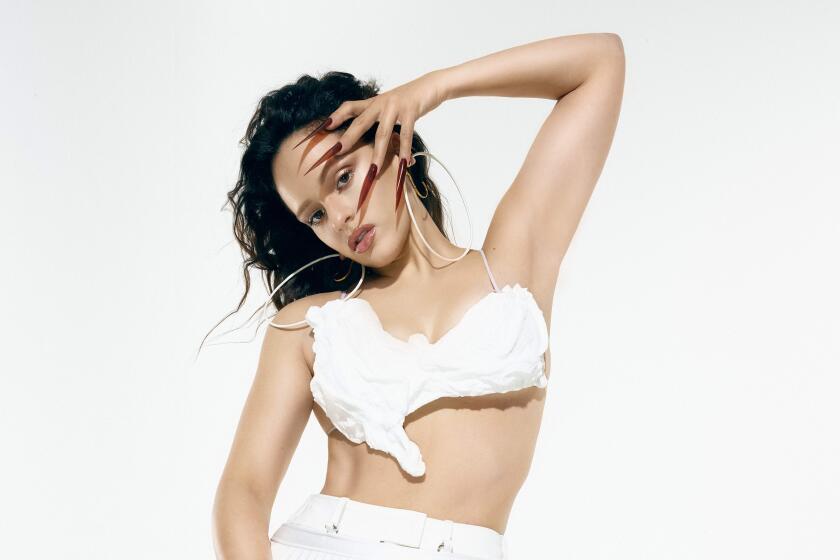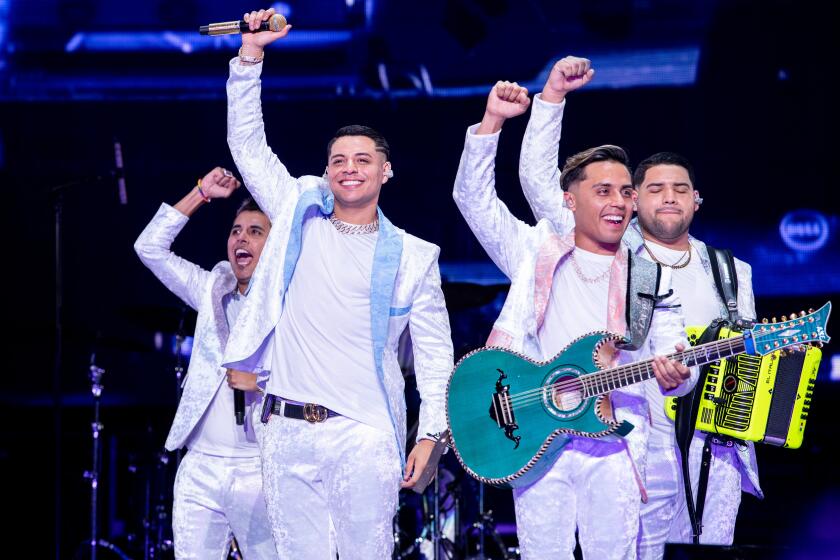How Rosalía’s ‘Motomami’ dares to defy genre and embrace sexuality: ‘How can I be freer?’

- Share via
Spanish avant-pop star Rosalía was just 8 years old when she rode her first motorcycle, her arms wrapped around her dad’s belly from the pillion seat as they blasted off into the hills, somewhere on the outskirts of her hometown of Barcelona. She says the trick to getting over the initial anxiety of riding a bike — and, more recently, of dropping her intrepid new album, “Motomami” — was keeping her focus fixed on the moment.
“What I love about riding a motorcycle is that you have to anchor yourself to the present,” she tells The Times, phoning in from a studio in Miami. “You can only think about what’s happening in the here and now. That way, you can move forward without looking back.”
In the three years and change since she released her Grammy-winning sophomore album, the 2018 flamenco-pop revelation titled “El Mal Querer,” Rosalía has come into her own as an international playgirl of sorts.
In 2019 she wooed fans at Coachella and rubbed elbows with the Kardashian-Jenner family; during the pandemic, she made a cameo in the video for Cardi B and Megan Thee Stallion’s incendiary “W.A.P.” and became main squeeze to Puerto Rican pop star Rauw Alejandro. (When I mention him, she only giggles.)
Released March 18, “Motomami” is a complex treatise on her newfound love and fame, as told through a head-spinning mesh of flamenco, hyperpop, hip-hop and assorted Caribbean sounds. It first required her to untether herself from the academic discipline that informed “El Mal Querer,” or “A Toxic Love”: a graduate thesis based on the 13th century novel “The Story of Flamenca,” which she first presented at the Catalonia College of Music. “This one is much more autobiographical,” she says of her latest project.
To fully flesh out the essence of “Motomami” — an avatar for her infinite pursuit of liberation “as both an artist and as a woman,” she says — she jetted among studios in Barcelona, Miami, Puerto Rico, the Dominican Republic, Los Angeles and New York over a span of two years. In that time she collaborated with a broad range of international artists, including the Neptunes, James Blake, the Weeknd and Tokischa.
The album debuted at No. 33 on the Billboard 200, the highest position for a Spanish-language album on the chart this year.
“It would have been easier if I replicated a formula from [‘El Mal Querer’], but I went to the studio with the urge to learn by experimentation,” she says. “I try to make music for people to enjoy, but if it ends up being challenging? Then it [served] a purpose.”
This summer, Rosalía will embark on her first-ever world tour, which kicks off on July 6 in Almería, Spain, and includes stops at Inglewood’s YouTube Theater on Oct. 7 and 8. She spoke to The Times about the road to releasing “Motomami” and where she’s headed next.
Where are you in this very moment?
I’m in Miami working on new music.
You’re already writing a new album?
I’m always working. I like to keep my creative wheels spinning. It’s a labor of love.
Your first two albums, “Los Ángeles” and “El Mal Querer,” were heavily informed by your scholarship in flamenco; in contrast, the genre explosion on “Motomami” feels very liberated.
The basis of “Motomami” was the pursuit of liberation. As an artist, my ultimate question has always been, “How can I be freer?”
How did you break free?
I spent two years away from my family and my country to make this record. It was hard, but it was clear to me that I didn’t want to spend those years sitting in front of my computer. Traveling so much these last few years has affected my sound, it affects my pencil, it affects my way of making music.

The “Motomami” song “Hentai” is such a pure pop expression of pleasure. (Lorde even sang a cover of the song at a recent NYC concert.) Did you feel any reservations about diving into your sexuality in your music?
My first two projects were totally me, but they took on a more solemn tone. Back then, I didn’t think that I had room to explore those themes, besides in the song “Di Mi Nombre.” This project is more hedonistic and indulgent, it’s much more autobiographical, and it shows off my sense of humor. It may surprise people, but I like to joke around! When I wrote “Chicken Teriyaki,” I was just having fun in New York. That’s why I liked playing with the contrast between the tender and the explicit in “Hentai.” What’s wrong with making a little wish list of the things you desire? What’s wrong with having a laugh?
Did you think that people wouldn’t receive this side of you well?
The feedback was mostly positive. But on TikTok, I noticed people were judging me for the 15 seconds they heard of the song, without any context. My references — like, Lil’ Kim and Madonna — sang way more explicit things a long time ago. People still harbor discomfort about a woman expressing herself openly about her sexuality, and I find that most surprising.
You’ve collaborated with some notable queer icons like Arca, Rita Indiana and Dominican rapper Tokischa, who appears on “Motomami.” What’s important about connecting with the queer community?
I feel that I’m part of the community. The majority of my friends, the people closest to me, are all part of the community. It makes all the sense in the world to me because it’s just my life. In the case of “Saoko” — “Drag queen makeup, I transform myself” — why not shine a little light on that?
You sample and reference many artists in your work — like reggaeton MC Wisin, who gets a credit on the track “Saoko” — but you cite your sources in the lyrics too, just like you’re citing a paper. Do you think your approach to music, whether pop or hip-hop or reggaeton, is still that of a student?
I never saw music in a compartmentalized way; I see it as a manifestation of our humanity. And what excites me about being a musician is challenging myself to study and understand new ways of expressing myself from other styles.

You spent much of your time in Puerto Rico and the Dominican Republic to work on songs for this album. Why was it critical for you to work in the Caribbean?
The Caribbean has an abundance of creativity, and I owe much to those places and to those artists. From the time I was 12 years old, I used to go with my cousins to the fair and we’d dance to reggaeton — they played Hector El Father, Don Omar, Daddy Yankee, etc. But you see, I only experienced that music from [Spain]. I know that reading about a place and experiencing it are two different things, and so my music wouldn’t exist in the same way if I hadn’t been able to spend time with the artists there. I have so much respect and admiration for them.
What was the production process like, bringing all these sounds together?
I mean, when you look at the corpus of flamenco, you can see hybridization is its natural tendency, and it always has been — ever since its inception. I always took inspiration from reggaeton, bachata, dembow … but there are traditional sounds like la guajira and la rumba too. I think of los cantes de ida y vuelta [flamenco songs inspired by Latin American folk songs during Spanish colonization], but how for contemporary artists, we now have the internet. That impacts our sounds so much, and you don’t even have to travel for that.
So the Internet made you international?
I basically grew up on the internet! We could say “Motomami” was made in six cities, but definitively, it was born from the internet. There is a cultural diversity today that did not exist before the internet was invented almost 30 years ago. In the end, I feel like a woman of the world.
More to Read
The biggest entertainment stories
Get our big stories about Hollywood, film, television, music, arts, culture and more right in your inbox as soon as they publish.
You may occasionally receive promotional content from the Los Angeles Times.













